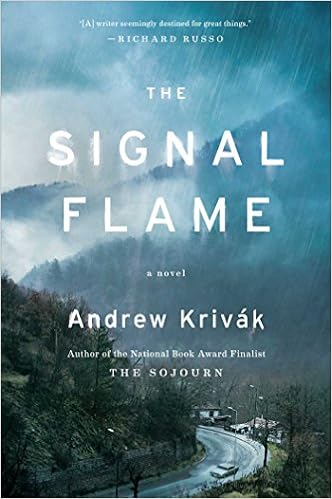4 Stars
This book is really a sequel to The Sojourn which tells the story of the formative years of Jozef Vinich. At the beginning of The Signal Flame, Jozef has just died. Left to mourn him are Hannah Konar, his daughter, and Bo, his grandson.
The novel
is set in 1972 in northeastern Pennsylvania.
Hannah, a widow, waits for the return of her youngest son Sam, a Marine
who has been designated as Missing in Action.
Bo, the older son, runs the family business, a roughing mill. He also keeps a protective eye on Ruth
Younger, Sam’s fiancée, whose family has had a problematic relationship with
Jozef’s family.
This is a
slow-paced novel, driven by character rather than plot. The characters are round characters who feel
like real people. Bo is the best example
of the fully-developed characters. He
is a quiet, dignified man with a strong sense of duty and a strong work
ethic. A steady, responsible person, he
always tries to do what is right. He
remembers what his grandfather taught him and manages the business so that
employees are respected and treated fairly.
One of the
themes is the damage that war inflicts on families. Though there are no battle scenes, war is
very much a presence in the novel. It
could be said that families are the collateral damage. Hannah’s husband fought in World War II and
returned “a hollow man”; and Sam enlisted to fight in Vietnam and his family
continues to deal with losing him. Reference
is made to Jozef’s experiences in World War I and to one of Ruth’s ancestors
fighting at Gettysburg. The indictment
of war is done indirectly, though a character cites a relevant statement by
Thucydides: “When a great confederacy,
in order to satisfy private grudges, undertakes a war of which no man can
foresee the issue, it is not easy to terminate it with honour.”
The book is
really about people trying to come to terms with loss. Hannah, mourning the loss of her husband,
father and a son, has concluded that loss is the only certainty in life: “she had come to believe that the only thing
one could be certain of was loss. The
loss of others as one lived on. Loss as the
last thing one left behind.” Virtually
everyone in the novel grieves the loss of a loved one. We learn about loss Bo experienced in the
past as we see him mourning the loss of his beloved grandfather; Ruth’s fiancé
is missing and she loses “in one day what most would mourn in a lifetime”; even
the local priest contends with losing a dear friend. The lesson about loss is perhaps best
expressed by Jozef in a conversation with Bo:
“That’s the nature of loss . . . You are both lessened and left
behind. There’s nothing to be done but
the work that’s been given, so the part of you that’s lessened doesn’t become
lost as well.”
The
characters in the novel are ordinary people.
There is a realism to them as they lead their ordinary lives. Sometimes, however, there is almost too much
of an effort to show this ordinariness by including excessive detail. For instance, Bo goes to check out a used saw
he is thinking of buying: “It was a DL
750, built in ’52 by the serial number . . . It would need a new chain, but the
lubrication unit was intact and most likely operative. He took off the spindle housing, and the air
gap clearance between the rotor and the stator was fine. Then he checked the pressure roll assembly
for wear and axial play, and everything looked good. Even the guide rail and the stock rail were
in nice shape.” Is all this detail
really necessary?
The ending
is rather predictable, but, as I’ve already stated, plot is not the most
important element. There is a
genuineness to the characters and their lives which will remain with the reader
who will also contemplate the losses in his/her own life.
Note: I received an ARC of this book from the publisher via NetGalley.

No comments:
Post a Comment